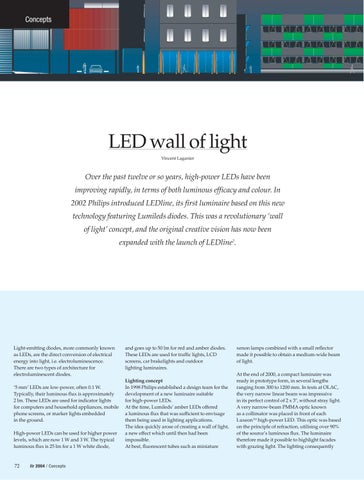Concepts
LED wall of light Vincent Laganier
Over the past twelve or so years, high-power LEDs have been improving rapidly, in terms of both luminous efficacy and colour. In 2002 Philips introduced LEDline, its first luminaire based on this new technology featuring Lumileds diodes. This was a revolutionary ‘wall of light’ concept, and the original creative vision has now been expanded with the launch of LEDline2.
Light-emitting diodes, more commonly known as LEDs, are the direct conversion of electrical energy into light, i.e. electroluminescence. There are two types of architecture for electroluminescent diodes. ‘5 mm’ LEDs are low-power, often 0.1 W. Typically, their luminous flux is approximately 2 lm. These LEDs are used for indicator lights for computers and household appliances, mobile phone screens, or marker lights embedded in the ground. High-power LEDs can be used for higher power levels, which are now 1 W and 3 W. The typical luminous flux is 25 lm for a 1 W white diode,
72
ilr 2004 / Concepts
and goes up to 50 lm for red and amber diodes. These LEDs are used for traffic lights, LCD screens, car brakelights and outdoor lighting luminaires. Lighting concept In 1998 Philips established a design team for the development of a new luminaire suitable for high-power LEDs. At the time, Lumileds’ amber LEDs offered a luminous flux that was sufficient to envisage them being used in lighting applications. The idea quickly arose of creating a wall of light, a new effect which until then had been impossible. At best, fluorescent tubes such as miniature
xenon lamps combined with a small reflector made it possible to obtain a medium-wide beam of light. At the end of 2000, a compact luminaire was ready in prototype form, in several lengths ranging from 300 to 1200 mm. In tests at OLAC, the very narrow linear beam was impressive in its perfect control of 2 x 3º, without stray light. A very narrow-beam PMMA optic known as a collimator was placed in front of each LuxeonTM high-power LED. This optic was based on the principle of refraction, utilising over 90% of the source’s luminous flux. The luminaire therefore made it possible to highlight facades with grazing light. The lighting consequently
